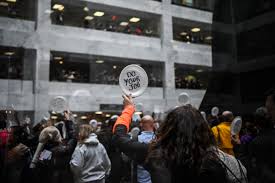The Government Shutdown Pushed Up U.S. Unemployment Rate in January

U.S. hiring in January topped all forecasts while wage gains cooled and the government shutdown pushed up the unemployment rate, signaling job gains remain robust without major inflation pressures that would worry Federal Reserve officials.
Nonfarm payrolls increased by 304,000, the most in almost a year, after a downwardly revised 222,000 gain the prior month, a Labor Department report showed Friday. The median estimate in a Bloomberg survey called for an increase of 165,000, following an initially reported 312,000 in December.
Average hourly earnings rose just 0.1% from the prior month, missing estimates. The annual gain of 3.2% matched forecasts though was down from an upwardly revised 3.3% in December. The jobless rate increased to 4%, reflecting the shutdown, as the number of unemployed on temporary layoff rose by 175,000, many of them federal workers, according to the department.
The figures, which included the highest participation rate since 2013, indicate the labor market remains in a sweet spot where companies are adding workers and boosting pay without suggesting any urgent need for the Fed to end its newfound patience on holding rates steady. Policy makers this week indicated they won’t hike again until inflation accelerates, even with the economy already roughly at the central bank’s goal of full employment.
The hiring and wage gains underscore resilient demand for labor, and support for consumer spending, even as the shutdown furloughed government workers, heightened uncertainty and weighed on economic activity. At the same time, economists had cautioned the data would contain more distortions than usual.
Shutdown Effects
The Labor Department found “no discernible impacts” of the shutdown on the establishment survey’s January estimates of employment, hours or earnings, acting labor-statistics commissioner William Wiatrowski said in a statement. Still, the shutdown likely hit some private industries, and some federal workers were probably misclassified as employed but absent from work instead of unemployed on temporary layoff, Wiatrowski said.
In addition, the number of Americans working part-time for economic reasons had an unusually large jump of about 500,000, which Wiatrowski said was almost all in the private sector and may reflect the shutdown. That pushed up the U-6, or underemployment rate, to 8.1% from 7.6%.
The shutdown was in effect for the week that included Jan. 12—the reference period for both the household survey, which produces the jobless rate, and the survey of establishments, which provides the payroll and wage figures.
Hundreds of thousands of federal employees who were furloughed were still included in the payrolls tally because they will collect back pay, though they would be considered unemployed in the household survey. But workers in related businesses, such as contractors, may have lost hours and earnings they may never fully recoup.
Economists had anticipated the jobless rate would experience some upward pressure related to the shutdown, instead of declining further amid the tight labor market. Even so, the rate remains well below the level that central bankers consider sustainable in the long run.
In January, gains in hiring included construction, with the biggest increase in almost a year. Leisure and hospitality, education and health, transportation and warehousing and retail all had solid advances. Manufacturing payrolls increased by 13,000, a five-month low.
While the job market looks healthy, it’ll be hard to match last year’s strength in employment, as the economy is projected to expand at a more moderate pace in 2019. The tax-cut tailwinds are likely to fade, the state of the trade war remains uncertain and global growth is cooling. In addition, businesses say the shortage of skilled workers is limiting plans to expand their workforce.
